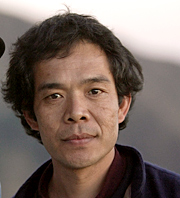Who are you? What defines who you are and how you maintain the individual sense of Self? These are the big questions of philosophy and psychology - questions about which no one agrees on the answers. Yet they are questions most of us wrestle with at some point (or many) in our lives.
The past few days,
Psychology Today has posted several articles/columns that examine these questions in one way or another. What follows is a little taste of each of the articles.
* * *
Self, Meet Yourself We don't always know ourselves as well as we think we do. Why we crave feedback to help enhance our self-awareness. By: Melanie LeTourneau
Psychology Today Magazine, Jul/Aug 2000
Have you ever been surprised by someone's description of you? Don't take it too hard: Research suggests we don't know ourselves as well as we think we do. Our identities may undergo constant reconstruction, suggests an article in the Psychological Review. Psychologists at Florida Atlantic University (FAU) reexamined research on developing individuality and concluded that our surroundings—social feedback, comparison with others, society's perception of our behavior—continually challenge us to redefine ourselves.
Individual levels of self-awareness vary, according to Robin R. Vallacher, Ph.D., an FAU psychology professor and co-author of the article. Those struggling to define themselves crave others' feedback to help enhance their self-awareness, he says, whereas those with a strong identity rely less on feedback: "They can reinterpret, reject or accept information based on their own coherent sense of self."
OK, so that was the whole article, but it seems to subtly support the Buddhist idea that "Self" is an illusion that is constantly shifting (absolute truth) in an effort to conform to environmental conditions, and also to suggest - to those of us who think about
ego states and subpersonalities - that our "parts" are constantly shifting in and out of control (relative truth).
* * *
Metaperceptions: How Do You See Yourself? To navigate the social universe, you need to know what others think of you—although the clearest view depends on how you see yourself.
Psychology Today Magazine, May/Jun 2005While many profess not to care what others think, we are, in the end, creatures who want and need to fit into a social universe. Humans are psychologically suited to interdependence. Social anxiety is really just an innate response to the threat of exclusion; feeling that we're not accepted by a group leaves us agitated and depressed.
The ability to intuit how people see us is what enables us to authentically connect to others and to reap the deep satisfaction that comes with those ties. We can never be a fly on the wall to our own personality dissections, watching as people pick us apart after meeting us. Hence we are left to rely on the accuracy of what psychologists call our "metaperceptions"—the ideas we have about others' ideas about us.
The bottom line: It comes down to what you think about yourself
Your ideas about what others think of you hinge on your self-concept—your own beliefs about who you are. "You filter the cues that you get from others through your self-concept," explains Mark Leary, professor of psychology at Wake Forest University in Winston-Salem, North Carolina.
Our self-concept is fundamentally shaped by one person in particular: Mama. How our mother (or primary caregiver) responded to our first cries and gestures heavily influences how we expect to be seen by others. "Children behave in ways that perpetuate what they have experienced," says Martha Farrell Erickson, senior fellow with the Children, Youth and Family Consortium at the University of Minnesota. "A child who had an unresponsive mother will act obnoxious or withdrawn so that people will want to keep their distance. Those with consistently responsive mothers are confident and connect well with their peers."
As an infant scans his mother's face he absorbs clues to who he is; as adults we continue to search for our reflections in others' eyes. While the parent-child bond is not necessarily destiny, it does take quite a bit to alter self-concepts forged in childhood, whether good or bad. People rely on others' impressions to nurture their views about themselves, says William Swann, professor of psychology at the University of Texas, Austin. His research shows that people with negative self-concepts goad others to evaluate them harshly, especially if they suspect the person likes them—they would rather be right than be admired.
The top line: You probably do know what people think of you
But it's likely you don't know any one person's assessment. "We have a fairly stable view of ourselves," says Bella DePaulo, visiting professor of psychology at the University of California at Santa Barbara. "We expect other people to see that same view immediately." And they do. On average there is consensus about how you come off. But you can't apply that knowledge to any one individual, for a variety of reasons.
For starters, each person has an idiosyncratic way of sizing up others that (like metaperceptions themselves) is governed by her own self-concept. A person you meet will assess you through her unique lens, which lends consistency to her views on others. Some people, for example, are "likers" who perceive nearly everyone as good-natured and smart.
Furthermore, if a particular person doesn't care for you, it won't always be apparent. "People are generally not direct in everyday interactions," says DePaulo. Classic work by psychologist Paul Ekman has shown that most people can't tell when others are faking expressions. Who knows how many interactions you've walked away from thinking you were a hit while your new friend was actually faking agreeability?
And there's just a whole lot going on when you meet someone. You're talking, listening and planning what you're going to say next, as well as adjusting your nonverbal behavior and unconsciously responding to the other person's. DePaulo calls it "cognitive busyness."
Because of all we have to contend with, she says, we are unable to effectively interpret someone else's reactions. "We take things at face value and don't really have the means to infer others' judgments." Until afterward, of course, when you mull over the interaction, mining your memory for clues.
This is a
much longer and more involved article. It raises some important issues about self-identity and social context, and also suggests that the more self-aware we are (especially about our emotions), the less buffeted we will feel by social situations and the opinions of others.
The article also goes into how various self-states impact how we see ourselves and how others see us, including shyness, being an "open system" in terms to new experiences, and physical awareness (how we present ourselves).
* * *
Dare To Be Yourself A sense of authenticity is one of our deepest psychological needs, and people are more hungry for it than ever. Even so, being true to oneself is not for the faint of heart. By: Karen Wright
Psychology Today Magazine, May/Jun 2008
It starts innocently enough, perhaps the first time you recognize your own reflection. You're not yet 2 years old, brushing your teeth, standing on your steppy stool by the bathroom sink, when suddenly it dawns on you: That foam-flecked face beaming back from the mirror is you.
You. Yourself. Your very own self.
It's a revelation—and an affliction. Human infants have no capacity for self-awareness. Then, between 18 and 24 months of age, they become conscious of their own thoughts, feelings, and sensations—thereby embarking on a quest that will consume much of their lives. For many modern selves, the first shock of self-recognition marks the beginning of a lifelong search for the one "true" self and for a feeling of behaving in accordance with that self that can be called authenticity.
A hunger for authenticity guides us in every age and aspect of life. It drives our explorations of work, relationships, play, and prayer. Teens and twentysomethings try out friends, fashions, hobbies, jobs, lovers, locations, and living arrangements to see what fits and what's "just not me." Midlifers deepen commitments to career, community, faith, and family that match their self-images, or feel trapped in existences that seem not their own. Elders regard life choices with regret or satisfaction based largely on whether they were "true" to themselves.
Questions of authenticity determine our regard for others, as well. They dominated the presidential primaries: Was Hillary authentic when she shed a tear in New Hampshire? Was Obama earnest when his speechwriters cribbed lines from a friend's oration?
"Americans remain deeply invested in the notion of the authentic self," says ethicist John Portmann of the University of Virginia. "It's part of the national consciousness."
It's also a cornerstone of mental health. Authenticity is correlated with many aspects of psychological well-being, including vitality, self-esteem, and coping skills. Acting in accordance with one's core self—a trait called self-determination—is ranked by some experts as one of three basic psychological needs, along with competence and a sense of relatedness.
Yet, increasingly, contemporary culture seems to mock the very idea that there is anything solid and true about the self. Cosmetic surgery, psychopharmaceuticals, and perpetual makeovers favor a mutable ideal over the genuine article. MySpace profiles and tell-all blogs carry the whiff of wishful identity. Steroids, stimulants, and doping transform athletic and academic performance. Fabricated memoirs become best-sellers. Speed-dating discounts sincerity. Amid a clutter of counterfeits, the core self is struggling to assert itself.
"It's some kind of epidemic right now," says Stephen Cope, author of Yoga and the Quest for the True Self. "People feel profoundly like they're not living from who they really are, their authentic self, their deepest possibility in the world. The result is a sense of near-desperation."
Just What Is Authenticity, Anyway?Psychologists long assumed authenticity was something too intangible to measure objectively. Certainly Michael Kernis did when, around 2000, graduate student Brian Goldman approached him about making a study of individual differences in authenticity.
"I said, 'Well, you can't do that,'" recalls Kernis, a social psychologist at the University of Georgia in Athens, "because nobody thought you could." But the two plunged ahead, reviewing several centuries' worth of philosophical and psychological literature. They came up with a technical description of authenticity as "the unimpeded operation of one's true or core self in one's daily enterprise."
Self-awareness is an element of the other three components as well. It's necessary for clarity in evaluating your strengths and (more to the point) your weaknesses: acknowledging when you've flubbed a presentation or when your golf game is off, without resorting to denial or blame. Authenticity also turns up in behavior: It requires acting in ways congruent with your own values and needs, even at the risk of criticism or rejection. And it's necessary for close relationships, because intimacy cannot develop without openness and honesty.
Kernis and Goldman have found that a sense of authenticity is accompanied by a multitude of benefits. People who score high on the authenticity profile are also more likely to respond to difficulties with effective coping strategies, rather than resorting to drugs, alcohol, or self-destructive habits. They often report having satisfying relationships. They enjoy a strong sense of self-worth and purpose, confidence in mastering challenges, and the ability to follow through in pursuing goals.
Whether authenticity causes such psychological boons or results from them isn't yet clear. But they suggest why people crave authenticity, as those low in authenticity are likely to be defensive, suspicious, confused, and easily overwhelmed.
Considering the psychological payoffs, Kernis and Goldman ask, "Why, then, is not everybody authentic?"
This is another deeper article, including a look at the "invented self," which deals with the notions of soul and the secularization of the Self in philosophy and culture.
To them, the self was not so much born as made. One's choice of action creates the self—in Sartre's words, "existence precedes essence." For Heidegger and confreres, authenticity was an attitude: the project of embracing life, constructing meaning, and building character without fooling yourself that your so-called essence matters in any absolute, a priori sense.
"The philosophical question is, do we invent this authentic self?" says Portmann. "Or do we discover it?" Socrates believed we discover it; the existentialists say we invent it.
The article goes on to dispel the sense of a solid, singular self, again confirming Buddhist philosophy at the absolute level and "parts" theory at the relative level. We aren't single selves, we contain multitudes (as Whitman asserted in the 19th century).
Today's psychologists no longer regard the self as a singular entity with a solid core. What they see instead is an array of often conflicting impressions, sensations, and behaviors. Our headspace is messier than we pretend, they say, and the search for authenticity is doomed if it's aimed at tidying up the sense of self, restricting our identities to what we want to be or who we think we should be.
Increasingly, psychologists believe that our notion of selfhood needs to expand, to acknowledge that, as Whitman wrote, we "contain multitudes." An expansive vision of selfhood includes not just the parts of ourselves that we like and understand but also those that we don't. There's room to be a loving mother who sometimes yells at her kids, a diffident cleric who laughs too loud, or a punctilious boss with a flask of gin in his desk. The authentic self isn't always pretty. It's just real.
We all have multiple layers of self and ever-shifting perspectives, contends psychiatrist Peter Kramer. Most of us would describe ourselves as either an introvert or an extrovert. Research shows that although we think of ourselves as one or the other (with a few exceptions), we are actually both, in different contexts. Which face we show depends on the situation. As Kramer puts it, "To which facet of experience must we be 'true'?"
This is a good discussion that raise a lot of questions about how and why we seek out authenticity in our lives, and why that it is much harder than we would like to think. Some of the conclusions indirectly support a lot of Buddhist psychology, which is always kind of cool.
* * *
Authentic and Eudaimonic
How to go with your gut and be true to yourself.
By: Karen Wright
Psychology Today Magazine, May/Jun 2008
8 Acts Of Authenticity
Experts offer their (sometimes conflicting) views on how to lead the authentic life.
- Read novels. "It's the best way to figure out what it feels like to be in someone else's head—and that's what helps us to distinguish our own identity." —John Portmann, professor of religious ethics, University of Virginia
- Meditate. "Meditative absorption creates moments of happiness not contingent on outcomes or external factors or manipulation of the environment. From that platform you can investigate how to create real fulfillment." —Stephen Cope, scholar-in-residence, Kripalu Center for Yoga and Health
- Be deliberate. "Authenticity consists in being aware that you have choices and consciously choosing what you do." —Roy Baumeister, social psychologist, University of Florida
- But not too deliberate. "People often make better decisions when they don't think about them. Go with your gut. Authentic reactions are much more at a gut level." —Mark Leary, social psychologist, Duke University
- Cultivate solitude. "Quiet and time for the self are a big plus. If you're worried about inauthenticity, there's nothing like shutting the door." —Peter Kramer, clinical psychiatrist, Brown University
- But stay connected. "Community is an outlook toward life in which you define yourself in relation to the world around you, rather than only in connection with yourself. I recommend enlarging the sense of self." —Thomas Moore, psychotherapist and author, A Life at Work
- Play hard. "Whether it's taking an art class, playing basketball, running, or just hanging out with friends, doing something you really enjoy allows you to express who you really are." —Michael Kernis, social psychologist, University of Georgia
- And be willing to lose. "Feelings of inauthenticity are heightened by a lack of a philosophy that allows failure to be part of life. If you're leading a full life, you're going to fail some every day." —Thomas Moore.
The New, True, Eudaimonic You Eudaimonia refers to a state of well-being and full functioning that derives from a sense of living in accordance with one's deeply held values—in other words, from a sense of authenticity. Some characteristics of the eudaimonic life include:
- Being open to experience without censorship or distortion
- Living fully in the moment, so the self feels fluid rather than static
- Trusting inner experience to guide behavior
- Feeling free to respond rather than automatically react to life events
- Taking a creative approach to living, rather than relying on routine and habit.
This is by the same author as the last article, offering some tips on how to be more authentic in our lives from many people you no doubt recognized.
Tags:
Psychology, Philosophy, consciousness, self exploration, Psychology Today, On the Self, Self Meet Yourself, Melanie LeTourneau, Metaperceptions, How Do You See Yourself?, Carlin Flora, Dare To Be Yourself, Karen Wright, Authentic and Eudaimonic, Authenticity, self awareness, social context, parts, selves, Buddhism










